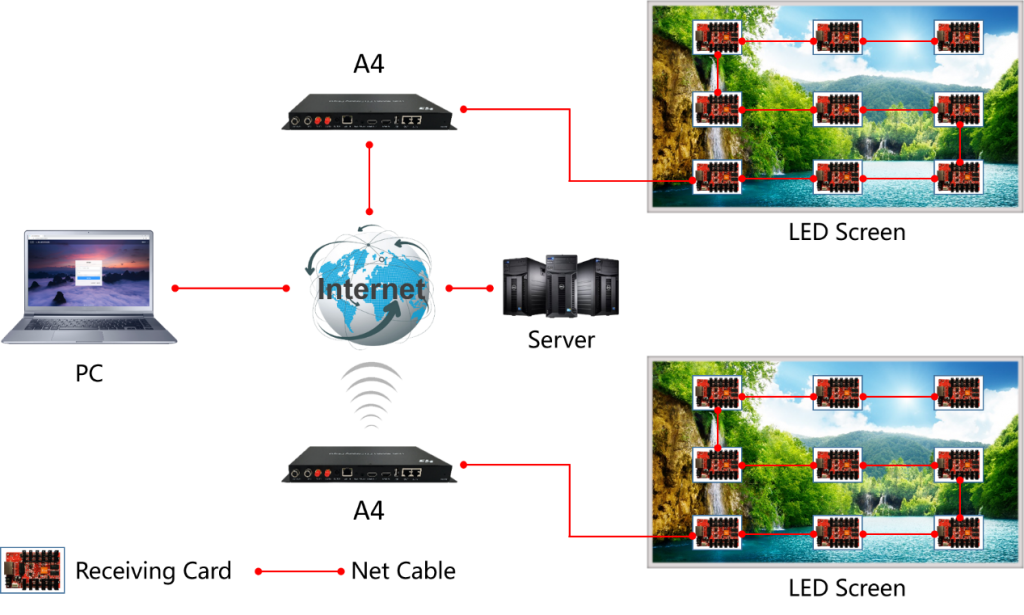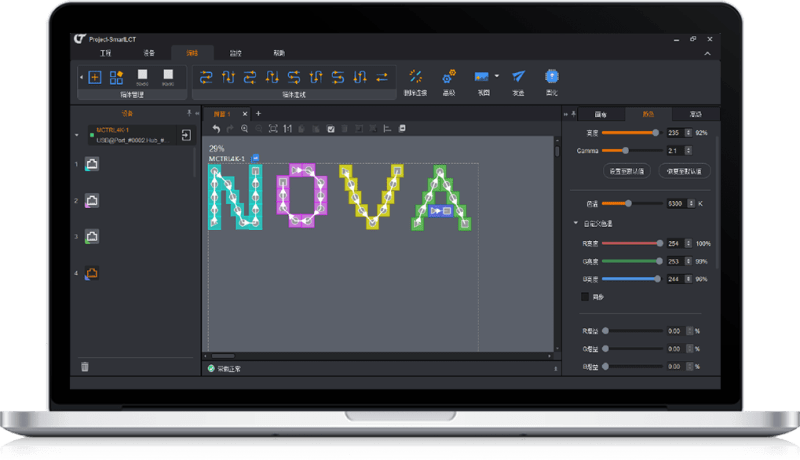How to realize the LED display control system
LED display control system, also known as LED display controller, LED display control card. It is the core component of the LED display. It is mainly responsible for receiving the picture and video display information from the computer serial port or DVI interface, placing it in the frame memory, and generating serial display data that can be recognized by the LED display according to the partition drive mode and scan control timing.
Through the analysis of the dot matrix module and the control circuit, the components of the LED display screen are determined; through the analysis of the single chip microcomputer and the intelligent control module, the composition structure and scanning driving mode of the LED display screen are determined to realize the display of the LED display screen.
According to the application of LED display control system, the architecture and workflow of LED graphic display are designed. Among them, the software system and the wireless transmission control hardware main system use serial communication to complete the program download and realize the transmission of text information.
Overall analysis of LED display control system
LED display system composition LED graphic display system consists of the software control system, wireless transmission system, equipment main controller, LED display dot matrix, power supply and other parts. The basic structure is as follows:

System working process: The main tasks of the software control system are graphic editing, font extraction and saving, image preview and file transmission; the wireless transmission system mainly completes the transmission of file information from the PC to the LED display, and the LED dot matrix in the hardware control system is mainly used. The task is to complete the information display through current control, drive the LED dot matrix row and column through the control of the scanning driving mode of the single chip, realize the driving of the device, and finally realize the received graphic and text display function.
Analysis and Design of Computer Software Modules
The software module is divided into an editing part and a control communication part. The editing part realizes the editing function of graphic files, and the communication part completes the transmission of files to the single-chip memory module through RS-232C serial communication. The communication part will be introduced in detail in Chapter 3. The system design adopts the Windows operating system, and the text editing window is opened.
The pixels in the client area are the same as those of the actual LED dot matrix display. The functions are similar to Word document editing tools, including editing modules, drawing modules, text editing modules, and color control module, display effect loading module, preview module, and information download module.
1 Edit module
1) In addition to the self-generated cut, copy, and paste functions of Windows, the system has added the functions of undo and repeat.
first. Select the undo function to realize the step-by-step cancellation function of the previous editing work. Then, select the repeat function to realize the most recent operation command of the previous editing work.

2) Drawing: Graphic drawing functions including lines, rectangles, ellipses, circles, etc.
3) Text editing: including text editing of various fonts, fonts, font sizes, effects, and colors, and adding text editing at specified locations according to the special purpose of the application.
First, select the text function, the font selection box will pop up, and you can select the text of various fonts for editing. After that, call up the specific text position editing dialog box, enter the text and the abscissa and ordinate the required display position.
4) Color control module: Due to the specific characteristics of the application field, three colors red, green and yellow are mainly used, which can realize color control.
2. Added effect module:
The function of the control system is improved by adding display effects and single-screen transmission of multi-screen files in transmission communication.
1) Normal effect, statically display the information on the screen.
2) The scrolling effect can realize the scrolling display of information from left to right and can be interspersed with static information.
3) Single-screen information transmission, realizing the saving of edited information to be transmitted.
4) Multi-screen information transmission, realizes the edited and saved single-screen information merged and saved into one file, which greatly reduces the cumbersomeness of file transmission.
3. Image preview module:
realize the preview function of font information before file transfer, can preview any form of font information saved before transfer, and directly integrate it into the toolbar file open function key button.
1) Display effects, through the preview before file transfer, you can adjust the order of static and scrolling display effects.
2) Display time, display the time interval between different screen display information. The software module structure diagram is as follows:
Control technology of LED display
With the development and use of the fifth-generation “array” control system, the birth of this generation of control systems has improved the technical advantages of screen control and further improved the processing technology of display signals. After using the “array” control system.
First of all, the frame-changing frequency of the display screen can be increased from the current 60Hz to above 120Hz, which is far greater than the resolution capability of human eyes, so that people can watch without any stroboscopic and water ripples, which improves the display quality.
Secondly, the gray level of the three primary colors of red, green and blue on the display screen can be increased from the current 256 to 1024, which makes the color more vivid, the color reproduction is better, and the displayed image is more realistic.
Utilizing the light-emitting mechanism of LED and the point-by-point correction technology, the color authenticity of the picture can be completely preserved, and the color loss and deviation of the picture caused by other display technologies, such as the material of the backlight projection and the light running path, can be completely avoided. True color reproduction.
Finally, the LDVS signal is used for transmission, which minimizes the loss of the signal, synchronizes the display content of the entire display, and improves the consistency of the display.
The LED display screen is no exception as a commonly used electronic display screen product. The number of times the electron beam scans the image on the screen repeatedly. The higher the number of scans, the higher the refresh rate, and the better the stability of the displayed image. Just like when we play games, we generally choose a screen with a higher hertz, so that playing games will feel the best
Conversely, if the refresh rate is low, the more flickering and jittering of the image, the faster the eyestrain. Under the high refresh rate of the LED display, the captured picture is stable, has no ripple black screen, clear image edges, and accurately restores the real information of the image itself.
In general, the control technology of the LED display can completely match the color level of the computer, so the LED display can now simulate and realize any existing color, which is inseparable from the improvement of the display in recent years.
